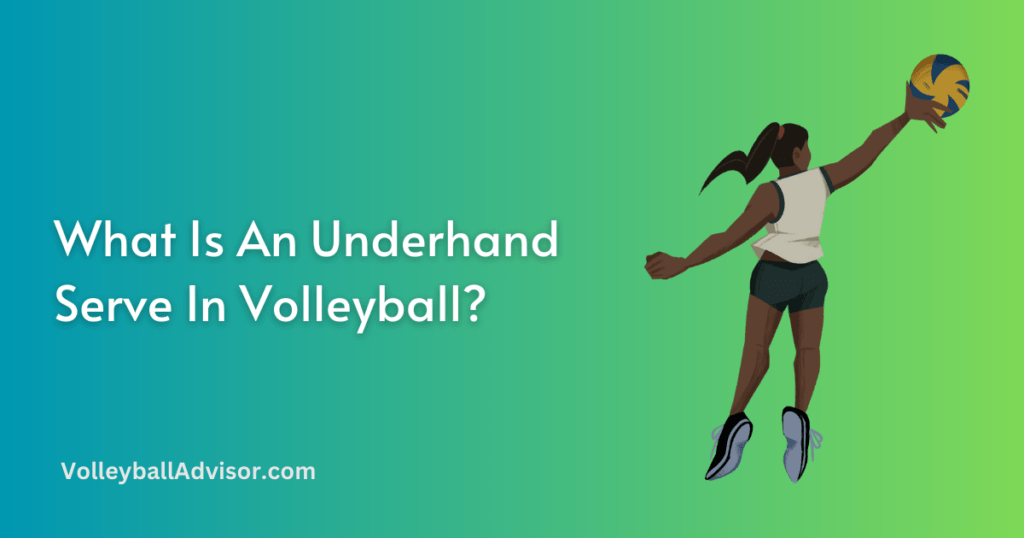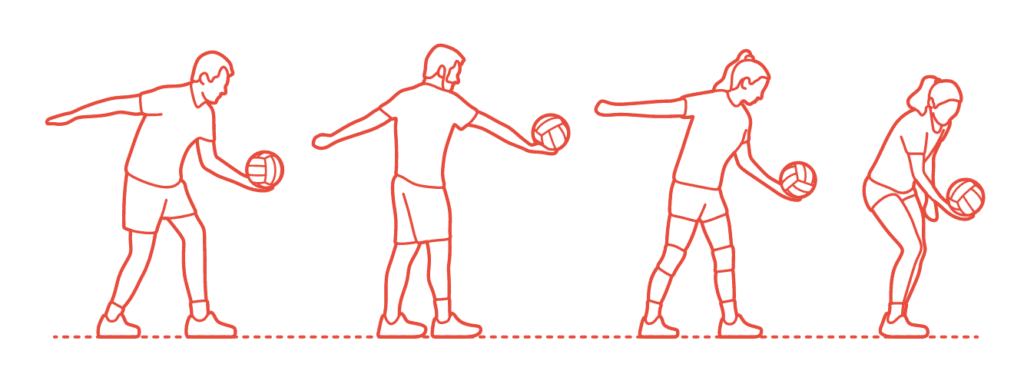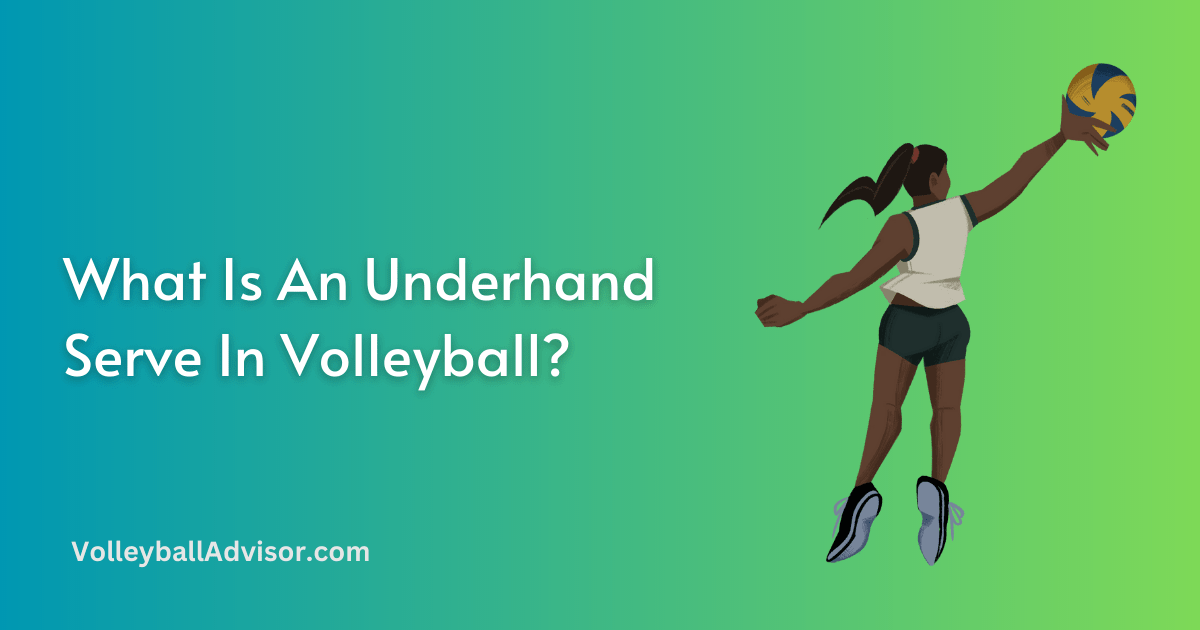There are several types of serves in volleyball, each with its own unique techniques and strategies.
Some of the most common serves include the underhand serve, overhand serve, float serve, and jump serve. Each type of serve requires a different skill set and offers different advantages and challenges for the server and receiver.

In this article, we will concentrate on the underhand serve, which is considered one of the most basic and beginner-friendly serves in volleyball.
Despite its simplicity, the underhand serve can be an effective weapon when executed correctly.
We will discuss the proper technique, advantages, and applications of the underhand serve, as well as provide tips for improvement and transitioning to more advanced serving techniques.
What Is An Underhand Serve In Volleyball?
The underhand serve is a type of serve in volleyball where the player strikes the ball with an upward and forward motion, using an underhand swinging technique.
The server’s arm remains below shoulder level throughout the entire motion, and the palm of the hand makes contact with the ball, propelling it over the net and into the opposing team’s court.

This serve is commonly taught to beginners due to its simplicity and ease of execution compared to other serves.
Key elements of an underhand serve
- Body positioning: The server’s feet should be shoulder-width apart, with the non-dominant foot slightly forward. The server’s body should be facing the target area on the opponent’s court.
- Ball grip: The non-dominant hand holds the ball at waist level, with a slight bend in the elbow.
- Arm motion: The server’s dominant arm should be bent at the elbow and positioned behind the body, with the hand open and the palm facing upward.
- Ball contact: The server strikes the ball with the heel of their palm, aiming for smooth and controlled contact.
- Follow-through: After making contact with the ball, the server’s arm should continue to swing forward and upward in a smooth, fluid motion.
Difference Between Overhand and Underhand serving in volleyball?
The overhand serve, also known as the topspin or float serve, is a more advanced serving technique that involves striking the ball with an overhead motion.
The server tosses the ball into the air and contacts it with an open hand while keeping its arm straight and at a high point.
The overhand serve typically generates more power and speed than the underhand serve, making it more difficult for the receiving team to control.
Some key differences between the underhand and overhand serves are:
- Technique: The underhand serve requires a swinging motion with the arm below shoulder level, while the overhand serve requires a more complex overhead striking motion.
- Power and speed: Overhand serves tend to be faster and more powerful than underhand serves, making them more challenging for the receiving team.
- Ball trajectory: Underhand serves generally follow a higher, more arched trajectory, while overhand serves can have a flatter, more direct path towards the target.
- Difficulty: The underhand serve is considered more beginner-friendly due to its simplicity, while the overhand serve requires more skill and practice to execute effectively.
- Spin: Overhand serves can impart various types of spin on the ball, such as topspin or float, which can make the ball’s trajectory unpredictable and difficult to receive. In contrast, underhand serves typically have less spin and are more predictable for the receiving team.
Despite these differences, both the underhand and overhand serves can be effective when executed correctly. The choice of serve often depends on the server’s skill level, experience, and the specific game situation.
Proper Technique for an Underhand Serve
Body positioning
Feet placement
To perform an underhand serve, stand with your feet shoulder-width apart, with your non-dominant foot slightly forward.
This staggered stance helps maintain balance and stability while serving. Face the target area on the opponent’s court to ensure proper alignment.
Posture and body alignment
Maintain a slight bend in your knees and keep your back straight, leaning slightly forward at the waist.
This posture helps generate power and control during the serve. Ensure that your shoulders, hips, and feet are aligned and facing the direction of your target area.
Arm and hand positioning
Non-dominant arm
Hold the ball with your non-dominant hand at waist level, positioning it in front of your non-dominant foot.
Your arm should be slightly bent at the elbow, and your palm should be facing upward to support the ball. Keep your gaze on the ball throughout the entire serving motion.
Dominant arm and hand
Now Position your dominant arm behind your body with the elbow bent and your hand open, palm facing upward.
Your fingers should be relaxed, and your wrist should be straight and in line with your forearm.
Ball contact and follow-through
Striking the ball
Begin the serving motion by swinging your dominant arm forward in a smooth, upward arc. As your arm approaches the ball, rotate your hand so that your palm faces the ball.
Make contact with the ball using the heel of your palm, aiming for a controlled and accurate strike.
The point of contact should be slightly above and in front of your non-dominant foot.
To achieve better accuracy, try to visualize the ball’s trajectory and aim for a specific target on the opponent’s court.
Follow-through and arm motion
After making contact with the ball, continue the forward and upward motion of your arm in a fluid, sweeping movement.
Your arm should naturally extend toward the target area, with your fingers pointing in the direction of the ball’s flight.
The follow-through is essential for maintaining accuracy and control during the serve.
Remember that practice and repetition are key to mastering the underhand serve technique.
As you become more comfortable with the motion, you can gradually increase the power and speed of your serve while maintaining control and accuracy.
Advantages of the Underhand Serve
Easier for beginners
The underhand serve is often considered the most beginner-friendly serving technique due to its simplicity and ease of execution.
Compared to more advanced serves, such as the overhand or jump serve, the underhand serve requires fewer complex movements and is easier to learn and master for players new to volleyball.
Lower risk of errors
As the underhand serve is less powerful and has a more predictable trajectory, it is generally associated with a lower risk of committing errors, such as hitting the ball out of bounds or into the net.
This can be advantageous in high-pressure situations where minimizing mistakes is crucial.
Better ball control
The underhand serve allows for greater control over the ball’s direction and placement on the opponent’s court.
This can be particularly useful for targeting specific areas or players on the receiving team, exploiting their weaknesses, and potentially gaining an advantage in the rally.
Possibility for strategic placement
Although the underhand serve may not be as fast or powerful as other serving techniques, it can still be used strategically to catch opponents off guard or force them to make adjustments.
By varying the placement, depth, and height of your serves, you can disrupt the opposing team’s formation and create opportunities for your team to score points.
When to Use the Underhand Serve
Beginner players and skill development
The underhand serve is ideal for beginner players who are still developing their volleyball skills.
It provides a solid foundation for learning the fundamentals of serving while allowing players to focus on their accuracy and consistency.
As players gain experience and confidence, they can gradually transition to more advanced serving techniques like the overhand serve or jump serve.
Windy conditions
In outdoor volleyball, windy conditions can significantly affect the flight of the ball, making it more challenging to execute precise serves.
The underhand serve’s relatively low speed and predictable trajectory can be advantageous in such situations, as it is less affected by the wind compared to faster and more powerful serves.
Using the underhand serve in windy conditions can help maintain control and minimize errors caused by unpredictable ball movement.
Strategic placement to exploit opponents’ weaknesses
The underhand serve can be employed as a strategic weapon to target specific weaknesses in the opposing team’s defense.
By varying the placement and depth of the serve, players can force the receiving team to adjust their formation or make difficult plays.
For example, a well-placed underhand serve might target a weaker passer, disrupt the setter’s position, or create seams in the opponent’s defense.
While the underhand serve may not have the speed or power of more advanced serves, its accuracy and control can still be used to exploit opponents’ weaknesses and create opportunities for your team to score points.
In summary, the underhand serve is a versatile and valuable technique that can be used effectively by players of all skill levels.
For beginner players, it serves as an excellent starting point for developing serving skills, while more experienced players can use it strategically to maintain control in challenging conditions or exploit weaknesses in the opponent’s defense.
Transitioning to Advanced Serves
When to consider learning other types of serves
As players gain experience and improve their volleyball skills, it is essential to expand their serving repertoire to remain competitive and versatile.
Generally, players should consider learning new serves when they have mastered the underhand serve and can consistently execute it with accuracy and control.
Transitioning to more advanced serves will provide a broader range of offensive options and make it more challenging for the opposing team to predict and defend against the serve.
Overhand serve: the next step
Once players are comfortable with the underhand serve, the overhand serve is the natural next step in skill progression.
The overhand serve involves a more complex overhead striking motion and can generate more power and speed than the underhand serve.
Learning the overhand serve will enable players to apply greater pressure on the receiving team, potentially leading to more scoring opportunities.
Jump serve and float serve: advanced options
For more advanced players, the jump serve and float serve offer additional offensive weapons.
The jump serve combines a powerful jump with a strong overhand strike, resulting in a high-speed, challenging serve for the opponent.
The float serve, on the other hand, relies on a strategic, minimal-spin contact that causes the ball to move unpredictably in the air, making it difficult for the receiving team to anticipate its trajectory.
Developing a diverse serving repertoire
A diverse serving repertoire is crucial for maximizing a player’s effectiveness on the court.
By mastering a variety of serving techniques, players can adapt their strategy to different game situations, exploit the weaknesses of their opponents, and keep the opposing team guessing.
In addition, having multiple serving options allows players to adjust their services based on their own strengths and weaknesses, as well as the conditions of the match (e.g., indoor vs. outdoor, level of competition, etc.).
To develop a well-rounded serving repertoire, players should practice and refine their skills in various serving techniques, observe and learn from experienced players, and consistently challenge themselves to grow and improve.
Conclusion
The underhand serve plays a crucial role in volleyball, providing an accessible and effective serving technique for players of all skill levels.
Its simplicity makes it an ideal starting point for beginners, while its accuracy and control enable more advanced players to use it strategically in various game situations.
By mastering the underhand serve, players can build a strong foundation for their volleyball skills and better understand the fundamentals of serving.
People Also Ask
An underhand serve is a type of volleyball serve where the player strikes the ball with an upward and forward motion, using an underhand swinging technique. The server’s arm remains below the shoulder level throughout the entire motion, and the palm of the hand makes contact with the ball, propelling it over the net and into the opposing team’s court.
The underhand serve is considered beginner-friendly due to its simplicity and ease of execution compared to other serves, such as the overhand serve or jump serve. It requires fewer complex movements, making it easier for players new to volleyball to learn and master.
To perform an underhand serve, stand with your feet shoulder-width apart and your non-dominant foot slightly forward. Hold the ball with your non-dominant hand at waist level, and position your dominant arm behind your body with the hand open and palm facing upward. Swing your dominant arm forward in a smooth, upward arc, making contact with the ball using the heel of your palm, and follow through with a fluid, sweeping arm motion.
Some advantages of the underhand serve include its suitability for beginners, lower risk of errors, better ball control, and strategic placement possibilities. These benefits make the underhand serve an effective and versatile technique for players of all skill levels.
Players should consider transitioning to more advanced serving techniques, such as the overhand serve or jump serve, once they have mastered the underhand serve and can consistently execute it with accuracy and control. Expanding one’s serving repertoire is essential for remaining competitive and versatile in the game.

